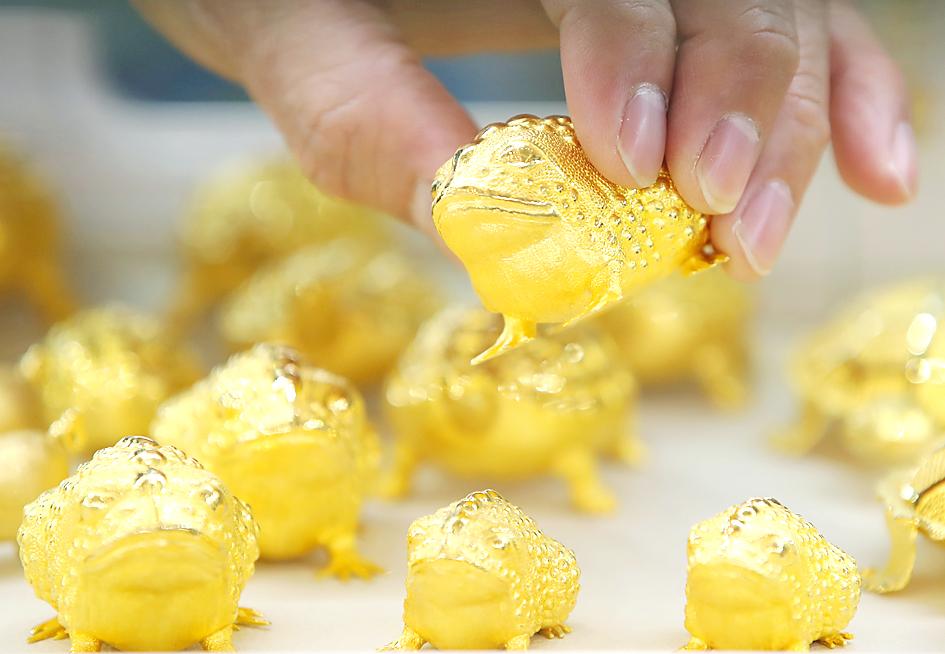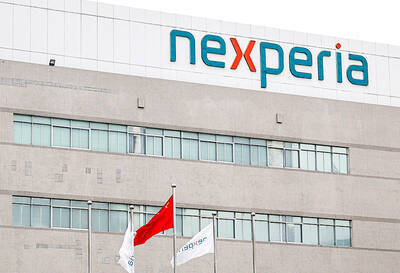Gold began the year with lofty expectations on the back of a record high and its biggest annual gain in a decade. Instead, the precious metal is off to its worst start in 30 years.
Spot prices on Friday touched a seven-month low before erasing losses as the US dollar moved lower, although bullion is already down more than 6 percent this year.
The metal, which surged last year on pandemic-induced haven buying, low interest rates and stimulus spending, is now this year’s’s worst performer in the Bloomberg Commodity Index.

Photo: EPA-EFE
It is suddenly facing a host of unexpected stumbling blocks. Chief among those are the surprising resilience in the US dollar and a rally in USTreasury yields, as economic indicators show recovery from the COVID-19 pandemic is well under way.
With “rates going higher and inflation expectations peaking out, we’re seeing a lot of profit-taking in gold, and people are going from gold into industrial metals such as copper,” said Peter Thomas, senior vice president at Zaner Group in Chicago. “It’s a perfect storm.”
Through Thursday, gold’s start to the year was the worst since 1991, data compiled by Bloomberg showed.
A gain in US Treasury yields is weighing on demand for non-interest-bearing bullion, with the metal extending losses after forming a so-called death-cross pattern earlier this week. Yields on 10-year Treasuries climbed to the highest level in about a year this week.
Inflation expectations have also climbed, with 10-year US breakevens touching the highest since 2014 earlier this week.
Still, that might not be as supportive for gold as it typically would be, Julius Baer Group Ltd analyst Carsten Menke said.
A “rapid recovery will inevitably lead to higher inflation. This should not be positive for gold as it is a good kind of inflation, reflecting an acceleration of economic activity, and not a bad kind of inflation, signaling a loss of trust in the US dollar,” he said in a note.
The economic recovery should prompt investors to sell some of their holdings of the haven, he said.
There are signs that is already happening, with holdings in gold-backed exchange-traded funds falling to the lowest since July, data compiled by Bloomberg showed.
Holdings are down about 1 percent this year and sustained outflows could prove a serious headwind.
Spot gold was down 0.38 percent at US$1,782.2367 an ounce. Futures for April delivery on the Comex rose 0.1 percent to settle at US$1,777.40 an ounce.
Still, some see prospects for gold to make a comeback, betting that the inability of governments and central banks to normalize stimulus policy will support the metal.
Goldman Sachs Group Inc said in late January that with prospects for additional stimulus and US Federal Reserve interest rates on hold, the metal “remains a compelling investment for the medium-to long-term investor.”
“For us, the behavior of gold at the moment resembles that of a tsunami: In the first phase, the water recedes (the gold price falls), and then in the second phase it comes back all the more violently,” Commerzbank AG analyst Daniel Briesemann said. “At the end of the year, we now see gold at US$2,000 per ounce.”
Additional reporting by Reuters

JITTERS: Nexperia has a 20 percent market share for chips powering simpler features such as window controls, and changing supply chains could take years European carmakers are looking into ways to scratch components made with parts from China, spooked by deepening geopolitical spats playing out through chipmaker Nexperia BV and Beijing’s export controls on rare earths. To protect operations from trade ructions, several automakers are pushing major suppliers to find permanent alternatives to Chinese semiconductors, people familiar with the matter said. The industry is considering broader changes to its supply chain to adapt to shifting geopolitics, Europe’s main suppliers lobby CLEPA head Matthias Zink said. “We had some indications already — questions like: ‘How can you supply me without this dependency on China?’” Zink, who also

The number of Taiwanese working in the US rose to a record high of 137,000 last year, driven largely by Taiwan Semiconductor Manufacturing Co’s (TSMC, 台積電) rapid overseas expansion, according to government data released yesterday. A total of 666,000 Taiwanese nationals were employed abroad last year, an increase of 45,000 from 2023 and the highest level since the COVID-19 pandemic, data from the Directorate-General of Budget, Accounting and Statistics (DGBAS) showed. Overseas employment had steadily increased between 2009 and 2019, peaking at 739,000, before plunging to 319,000 in 2021 amid US-China trade tensions, global supply chain shifts, reshoring by Taiwanese companies and

Taiwan Semiconductor Manufacturing Co (TSMC, 台積電) received about NT$147 billion (US$4.71 billion) in subsidies from the US, Japanese, German and Chinese governments over the past two years for its global expansion. Financial data compiled by the world’s largest contract chipmaker showed the company secured NT$4.77 billion in subsidies from the governments in the third quarter, bringing the total for the first three quarters of the year to about NT$71.9 billion. Along with the NT$75.16 billion in financial aid TSMC received last year, the chipmaker obtained NT$147 billion in subsidies in almost two years, the data showed. The subsidies received by its subsidiaries —

At least US$50 million for the freedom of an Emirati sheikh: That is the king’s ransom paid two weeks ago to militants linked to al-Qaeda who are pushing to topple the Malian government and impose Islamic law. Alongside a crippling fuel blockade, the Group for the Support of Islam and Muslims (JNIM) has made kidnapping wealthy foreigners for a ransom a pillar of its strategy of “economic jihad.” Its goal: Oust the junta, which has struggled to contain Mali’s decade-long insurgency since taking power following back-to-back coups in 2020 and 2021, by scaring away investors and paralyzing the west African country’s economy.